The Desktop Kabini Review Part 1: AMD Athlon 5350 (AM1) Tested
by Ian Cutress on April 9, 2014 8:00 AM ESTIGP Comparison, Synthetics
AMD’s graphics stack from top to bottom is all based on the Graphics Core Next architecture. This is an update from earlier VLIW implementations, offering for scalability from low power all the way up to high performance. At the heart of an AMD graphics system is the compute unit comprising of 64 GPU cores. Each compute unit can act independently, ensuring that multiple tasks can complete as quickly as possible due to multiple kernel dispatch across the entire core. In the Kaveri APU launch we were dealing with APUs that contained 6 or 8 compute units for 384/512 cores. With this level of performance, gaming at 1080p30 was possible on most titles depending on how the quality settings were configured. For Kabini, the entire range is given two compute units, with individual processors differing in clock speed.
With two compute units, we are not expecting much from the gaming aspect of these APUs in terms of ‘the latest’ titles. Our benchmarks in the next few pages show that even F1 2013 at 1280x1024 on low settings, unless the engine powering the game is basic, 25 FPS minimum is a hopeful target. This lack of horsepower may limit these APUs to Flash based titles, perhaps even some of the more reasonable Unity games. In AMD’s slide deck they quote games such as Minecraft, Lego Marvel Superheroes and Bastion as the sort of titles that a Kabini player should aim for.
There is some confusion regarding the naming convention of these integrated graphics solutions. Soldered on Kaveri parts designed for all-in-ones, such as the A6-5200, use the HD8000 naming scheme, such as the HD8400. The Athlon 5350 is analogous in design to the A6-5200 except for a 50 MHz speed bump and the name of the IGP – here this is designated as the R3 series. This is despite retailers who are currently selling this APUs and labeling them with the HD8000 designations.
Like Kaveri, the integrated graphics solution in Kabini features an updated Video Codec Engine and Unified Video Decoder giving hardware support for H.264.
AMD is also promoting their Picture Perfect solution, using additional post processing tools to increase video quality on the fly:
Also rather interestingly AMD is claiming an enhanced decoder for JPEG files. Given that one of the primary uses for a Kabini system might be for web access where JPEGs are standard, AMD has been promoting up to a 2x performance increase over a J2900 system:
AMD’s secret sauce, according to their slides, appears to be heterogeneous computing. This would be the ideal usage scenario for computing going forward.
GPU Synthetics
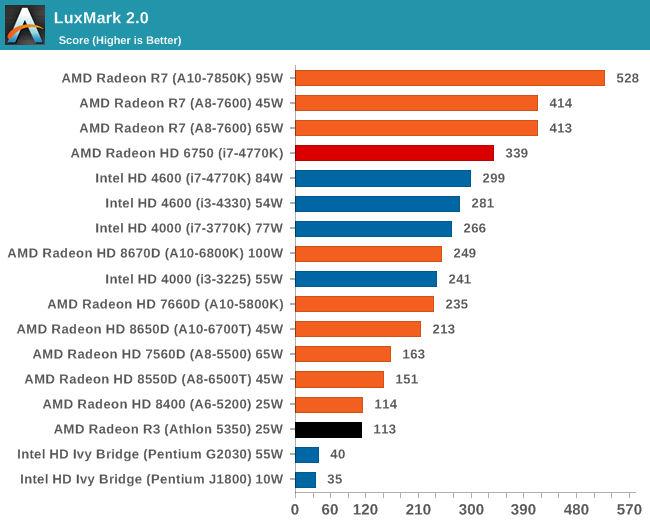
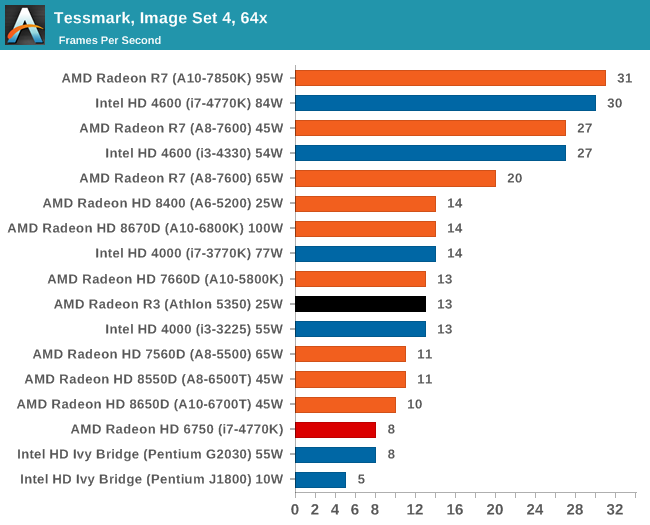


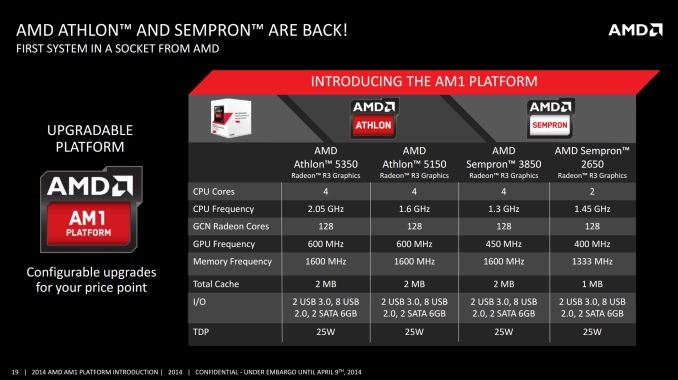
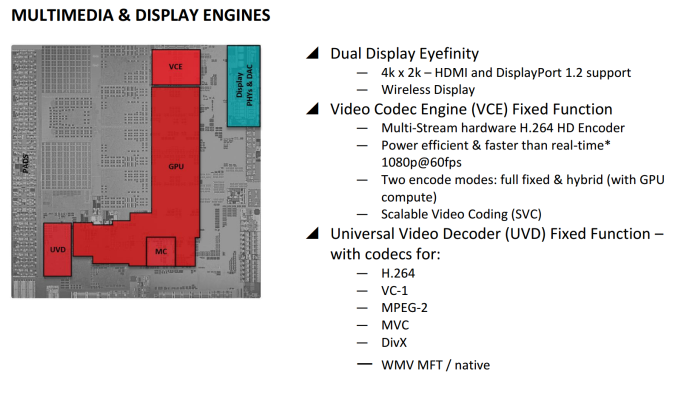
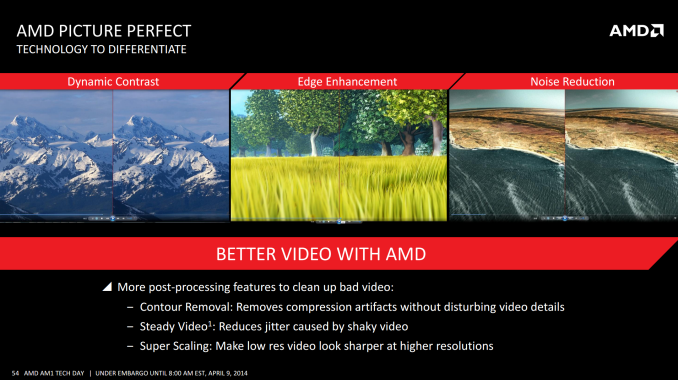
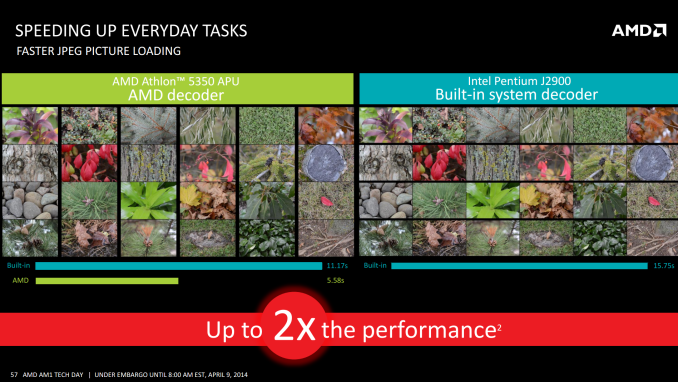
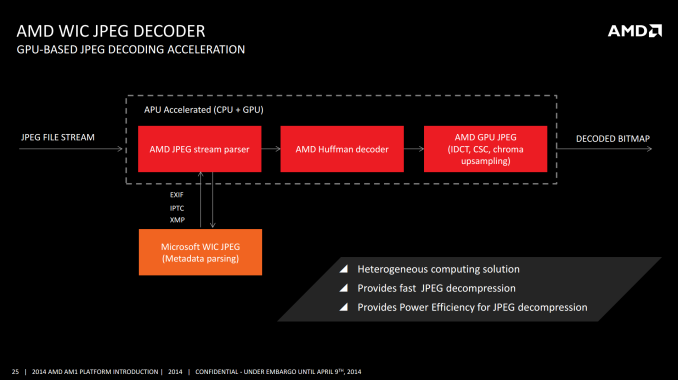








126 Comments
View All Comments
tomsworkshop - Friday, April 11, 2014 - link
i think these chips are nice for 12"-13" slim laptop, and don't if it is soldered on board, is about time they replace the current E350 APU on mobo with jaguar core chips, maybe the GDDR5 sideport memory onboard will be a nice feature.Hrel - Friday, April 11, 2014 - link
I don't even know why they're bothering, these performance numbers are useless.Oscarcharliezulu - Saturday, April 12, 2014 - link
PC's wont compete with tablets by being cheap, they compete by being awesome - 4k screens, fast ssd's, great 3d graphics, cloud storage so you can work anywhere, great games at ultra HD....hangfirew8 - Monday, April 14, 2014 - link
...and a full-sized keyboard and mouse.Antronman - Monday, April 21, 2014 - link
Microsoft solved that problem.Heck, some of the Surface tablets have serious CPU computing power.
PCs compete by having better price/performance, and yes being generally better.
I'd like to see UE4 on an iPad air :P
plonk420 - Sunday, April 13, 2014 - link
on my 19 watt E-350 (microATX, also see http://www.anandtech.com/show/4996/ ), i removed the tiny, possibly whiny fan, and secured a PWM 120mm Arctic Cooling fan over it. that with a PC Power and Cooling Silencer, and it was so quiet, i could hear my fridge and other PCs around the apartment, it was so quiet.fteoath64 - Sunday, April 13, 2014 - link
How could a dual core chip clocked at less than 1.5Ghz with gpu at 400Mhz have a TDP of 25 watts ?!!!. Even an Arm chip clocked at 1.9Ghz have a TDP of about 5 watts. How can x86 compete really in terms of price performance and power ?!. These are throw away chips with such power consumption levels.0ldman79 - Sunday, April 13, 2014 - link
Any way we could get some FX processors in the benches?I know that AM3+ is probably a dead line, but we've still got the machines out in the world. I'd like to know where my PC lines up without having to find an FX 6300 compared to a Core i5 compared to an A8.
payton2037 - Sunday, April 13, 2014 - link
Start a Second Income™with the company that's first with Internet entrepreneurs!For more Details Please visit at :--
http://www.sfi4.com/14161637/FREE
duploxxx - Monday, April 14, 2014 - link
And yet again we have to find out that in the conclusion the review start to focus on cpu performance only and compairing with totally different types of cpu to make this kabini look bad especially the single threaded performance. while it is on par with latest generation of intel or on multithreaded way better.http://www.anandtech.com/show/7933/the-desktop-kab...
not a single word in the conclusions on graphics which again shows how bad all these intel parts really are... even these latest generations.
I often wonder that reviewer background and how neutral they actually are and look at a certain system from a certain perspective, sure my ferrari will run faster then a fiat, but look at the purpose and design...